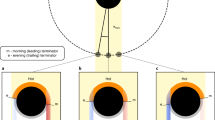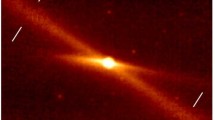Abstract
On July 28, 2006 the 6-m telescope of the Special Astrophysical Observatory of the Russian Academy of Sciences recorded the spectrum of a faint meteor. We confidently identify the lines of FeI and MgI, OI, NI and molecular-nitrogen (N2) bands. The entry velocity of the meteor body into the Earth’s atmosphere estimated from radial velocity is equal to 300 km/s. The body was several tens of a millimeter in size, like chondrules in carbon chondrites. The radiant of the meteor trajectory coincides with the sky position of the apex of the motion of the Solar system toward the centroid of the Local Group of galaxies. Observations of faint sporadic meteors with FAVOR TV CCD camera confirmed the radiant at a higher than 96% confidence level. We conclude that this meteor particle is likely to be of extragalactic origin. The following important questions remain open: (1) How metal-rich dust particles came to be in the extragalactic space? (2) Why are the sizes of extragalactic particles larger by two orders of magnitude (and their masses greater by six orders of magnitude) than common interstellar dust grains in our Galaxy? (3) If extragalactic dust surrounds galaxies in the form of dust (or gas-and-dust) aureoles, can such formations now be observed using other observational techniques (IR observations aboard Spitzer satellite, etc.)? (4) If inhomogeneous extragalactic dust medium with the parameters mentioned above actually exists, does it show up in the form of irregularities on the cosmic microwave background (WMAP etc.)?
Similar content being viewed by others
References
M. Hapgood, P. Rothwell, O. Royvik, MNRAS 201, 569, (1982).
J. Borovicka, R. Stork, J. Bocek, Meteorics and Planetary Science, 34 987, (1999).
J. Stauffer, H. Spinrad, PASP 90, 222, (1978).
V. L. Afanas’ev, A. V. Moiseev, Pis’ma Astron. Zh. 31, 214, (2005).
J. Borovicka, O. P. Popova, A. P. Golub, et al., Astronom. and Astrophys. 33, 591, (1998).
J. M. Trigo-Rodriguez, J. Llorca, J. Borovicka, J. Fabrecant, Meteorits & Planetary Science 38, 1283, (2003).
V. A. Kamenshchikov, Yu. A. Plastinin, V. M. Nikolaev, L. A. Novitskii, Radiatsionnye Svoistva Gazov pri Vysokikh Temperaturakh (Radiation Properties of Gases at Hight Temperatures), (Mashinostroenie, Moscow, 1971) (in Russian).
D. P. Galligan, W. J. Baggaley, MNRAS 359, 551, (2005).
A. D. Taylor, W. J. Baggaley, R. G. T. Bennet, D. I. Steel, Planetary and Space Science 42, 135, (1994).
I. D. Karachentsev, D. I. Makarov, AJ, 111, 794, (1996).
V. V. Kalenichenko, Kinematica Fiz. Nebesnykh Tel 8, 69, (1992).
V. V. Kalenichenko, Astron. Vetsnik. 14, 86, (1982).
CIRA 1972, Cospar International Reference Atmosphere (Berlin, Akademie-Verlag, 1972), 450 pp.
V. V. Kalenichenko, Kinematica Fiz. Nebesnykh Tel 8, 61, (1992).
V. V. Kalenichenko, Kinematica Fiz. Nebesnykh Tel 9, 52, (1993).
V. A. Bronshten, Fizika Meteornykh Yavlenii (Physics of Meteor Phenomena), (Nauka, Moscow, 1981), 416 (in Russian).
V. V. Kalenichenko, Kinematica Fiz. Nebesnykh Tel 20, 157, (2004).
K. A. Hill, L. A. Rogers, R. L. Hawkes, Astronom. and Astrophys. 444, 615, (2005).
R. T. Dodd, Meteority. Petrologiya i Geokhimiya, (Mir, Moscow, 1986), 384 (in Russian). Translated from R. T. Dodd. Meteorites — a Petrologic-Chemical Synthesis. Chemistry University Press, 1981. 368 pp
S. Karpov, G. Beskin, A. Biryukov, et al., I., IL NUOVO CIMENTO 28, 747, (2005).
I.D. Karachentsev, AJ, 129, 17, (2005)
I. D. Karachentsev and V. A. Lipovetsky, Astron. Zh. 45, 1148, (1968).
F. Fraternali, J. Binney, T. Oosterloo, and R. Sancisi, New Astronomy Review 51, 95, (2007).
Author information
Authors and Affiliations
Additional information
Original Russian Text © V.L. Afanasiev, V.V. Kalenichenko, I.D. Karachentsev, 2007, published in Astrofizicheskij Byulleten, 2007, Vol. 62, No. 4, pp. 319–328.
Rights and permissions
About this article
Cite this article
Afanasiev, V.L., Kalenichenko, V.V. & Karachentsev, I.D. Detection of an intergalactic meteor particle with the 6-m telescope. Astrophys. Bull. 62, 301–310 (2007). https://doi.org/10.1134/S1990341307040013
Received:
Accepted:
Issue Date:
DOI: https://doi.org/10.1134/S1990341307040013




